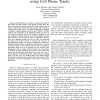INTERSPEECH
2010
14 years 3 months ago
2010
This paper presents a new approach to language model construction, learning a language model not from text, but directly from continuous speech. A phoneme lattice is created using...
COLING
2010
14 years 3 months ago
2010
We present a new reordering model estimated as a standard n-gram language model with units built from morphosyntactic information of the source and target languages. It can be see...
EMNLP
2009
14 years 6 months ago
2009
We have designed, implemented and evaluated an end-to-end system spellchecking and autocorrection system that does not require any manually annotated training data. The World Wide...
ACL
2009
14 years 6 months ago
2009
We describe Joshua (Li et al., 2009a)1, an open source toolkit for statistical machine translation. Joshua implements all of the algorithms required for translation via synchronou...
ACL
2006
14 years 9 months ago
2006
In this paper, we argue that n-gram language models are not sufficient to address word reordering required for Machine Translation. We propose a new distortion model that can be u...
ACL
2004
14 years 9 months ago
2004
We present the first application of the head-driven statistical parsing model of Collins (1999) as a simultaneous language model and parser for largevocabulary speech recognition....
COLING
2008
14 years 9 months ago
2008
User logs of search engines have recently been applied successfully to improve various aspects of web search quality. In this paper, we will apply pairs of user queries and snippe...
ACL
2008
14 years 9 months ago
2008
In this paper, we propose a novel string-todependency algorithm for statistical machine translation. With this new framework, we employ a target dependency language model during d...
CSE
2009
IEEE
15 years 3 months ago
2009
IEEE
—Mobile devices can produce continuous streams of data which are often specific to the person carrying them. We show that cell phone tracks from the MIT Reality dataset can be u...


